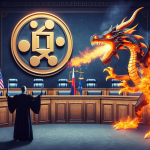On March 6, 2025, President Donald Trump enacted an executive order initiating the creation of a strategic Bitcoin reserve, which could financially benefit taxpayers while reinforcing the U.S.’s leadership role in digital finance. Critics, however, caution against the government’s involvement with such a volatile asset lacking inherent value and question potential conflicts due to political contributions and the Trump family’s financial stakes in cryptocurrency.
Conceived from his campaign promises in 2024, the strategic reserve initiative aims to position America at the forefront of the crypto landscape and offer a buffer against economic disturbances. Utilizing seized cryptocurrency assets managed by the Treasury, Trump’s pro-crypto stance mirrors a heightened interest in digital-asset growth. Yet, critics argue that the initiative is fraught with conflicts of interest and minimal strategic value.
In his 2024 campaign, Trump pledged to dismantle regulations from the Biden era and transform the U.S. into a global epicenter for digital assets. An AI and crypto “czar” appointment was part of his strategy to advance blockchain innovation.
With a focus on diversification through digital assets, his platform resonated with proponents of Bitcoin’s limited supply and global utility as “digital gold,” advocating for its place among traditional reserves like oil and foreign currencies.
Critics, however, underscore that unlike tangible assets like gold or oil, cryptocurrencies lack intrinsic value and strategic commercial use. Moreover, they highlight the financial risks tied to holding large amounts of volatile assets, posing potential losses for taxpayers.
Through the executive order, all cryptocurrencies confiscated in legal proceedings will form the core of the Strategic Bitcoin Reserve, consolidated within the Treasury. With estimates placing the U.S. government’s Bitcoin holdings at approximately $17 billion, federal agencies are tasked with reviewing additional assets under their management for potential integration into the reserve.
While initial funding relies on confiscated assets, the order grants the Secretaries of Treasury and Commerce the latitude to develop “budget neutral” methods for acquiring more Bitcoin, including market purchases.
A specialized office within the Treasury will oversee the reserve’s management, implementing strategies such as proof-of-reserve. The framework mandates that all Bitcoin holdings remain unsold, preserving their status as a strategic value reserve.
Regulatory Landscape of Cryptocurrency
Despite Trump’s mandate, digital currencies navigate through a convoluted regulatory environment across varying governmental levels. State and federal regulations range from stringent licensing requirements to supportive measures for blockchain enterprises.
Alongside the Bitcoin reserve plan, the executive order also advocates for a flexible asset management strategy, as heralded in Trump’s communications, facilitating their strategic use or eventual sale.
Critics argue that diversifying the reserve with alternative coins lacks rationale and may lead to market distortion. Unlike Bitcoin, these coins are commercial products tied to specific entities, potentially favoring crypto magnates who backed Trump’s political campaign.
The Strategic Bitcoin Reserve represents a groundbreaking endeavor to embed digital currencies within the national economic framework. While it has the potential to elevate the U.S. to a leading position in the global crypto industry, questions persist about the reserve’s strategic benefit and the possibility of conflicts of interest involving Trump and his family.







